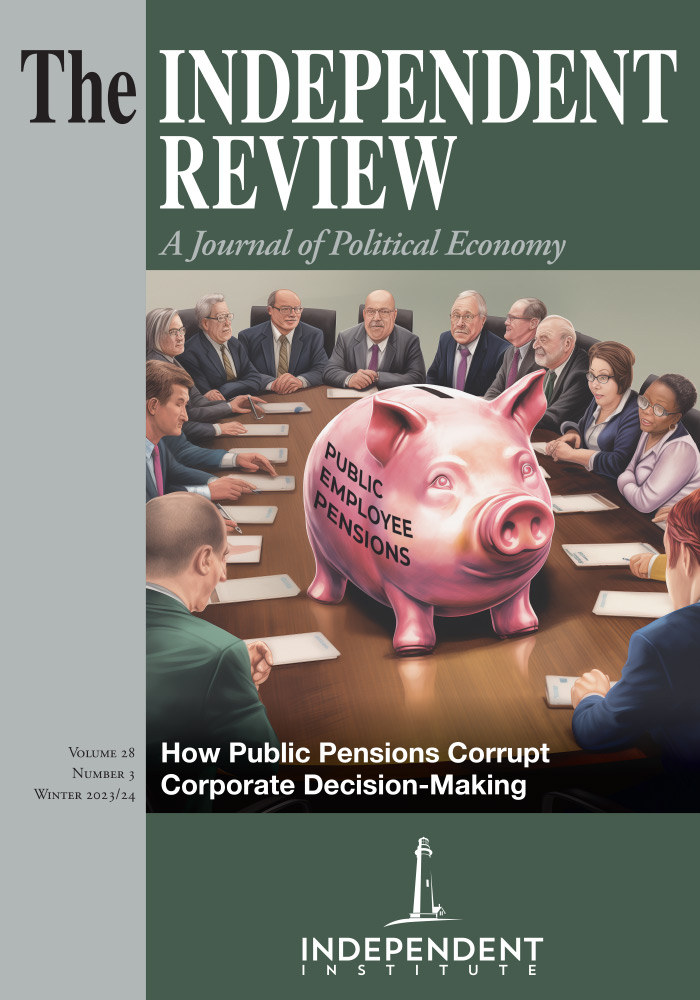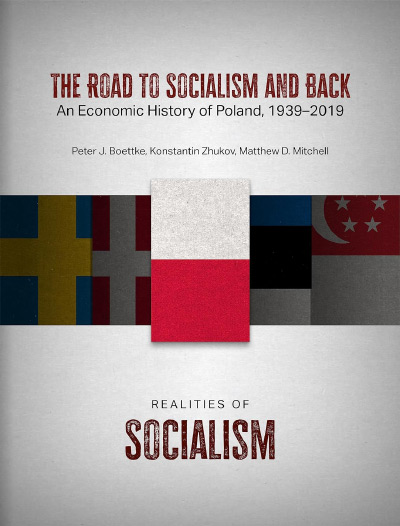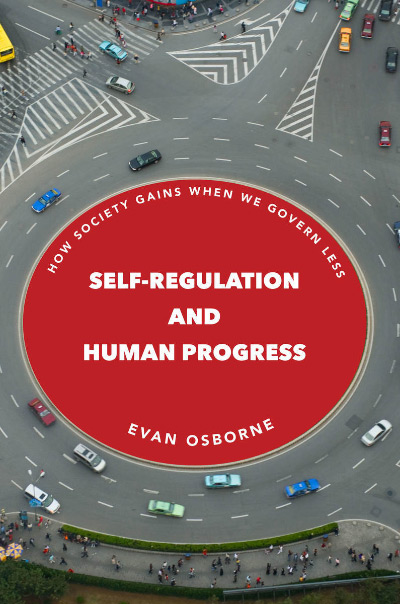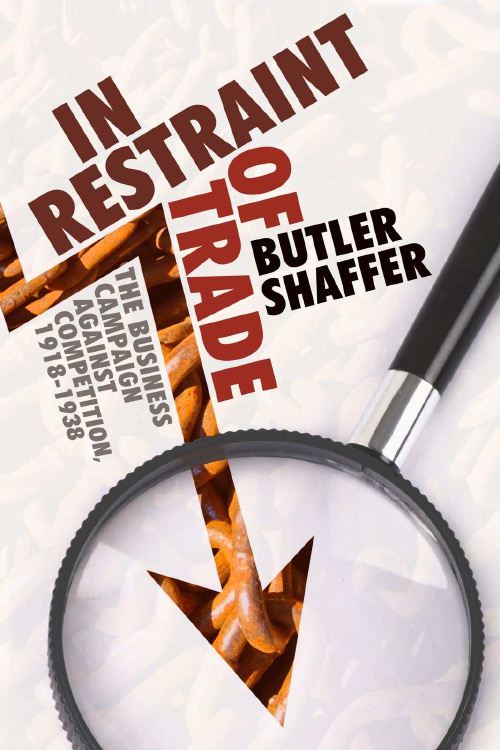About a year ago, Tyler Cowen identified Poland as an underrated nation and pointed out forecasts that see Poland catching up with the United Kingdom’s standard of living in roughly a decade (Poland Projection of the Day, Marginal Revolution, November 2022). This prediction is puzzling, considering Poland’s past struggles with poverty, its rocky transition from socialism to a mixed economy, and the recent turn away from democracy. For anyone wishing to understand Poland’s dramatic transformation and its prospects, the newly published The Road to Socialism and Back: An Economic History of Poland, 1939–2019 by Peter J. Boettke, Konstantin Zhukov, and Matthew Mitchell could not come at a better time.
Boettke, Zhukov, and Mitchell document Poland’s socioeconomic journey from a mixed economy to a centrally planned socialist state and back, highlighting the gap between the ideals of socialist ideology and the harsh realities experienced by the Polish people. The book underscores the value of economic freedom by showing how a return to a mixed economy, although painful, led to significant improvements in the standard of living. Furthermore, the book contributes to the understanding of market processes by highlighting the role of property rights in economic calculation. Written in an accessible style and enhanced with graphs and timelines, the book caters to a broad audience. In addition, readers can turn to the accompanying website, which offers videos, infographics, and charts.
The book opens with a chapter on the political economy of socialism, echoing Boettke’s influential contributions to Soviet Studies (e.g., 1990, Soviet Union: The Political Economy of Soviet Socialism, Boston, Mass.: Kluwer Academic Publishers). In that earlier work, Boettke’s analysis of the political economy of the Soviet Union led him to explore and document the internal contradictions of socialism. Here, these contradictions are analyzed in the context of Polish socialism, with the authors focusing on three challenges of socialist planning: the control problem, the knowledge problem, and the incentive problem. The control problem refers to the omnipresent coercion necessary for overriding individuals’ plans to work, shop, invest, and exchange. The knowledge problem occurs when the market process of discovery and knowledge creation is restricted. Lastly, the incentive problem emerges when individuals are prevented from advancing their well-being ethically. Combined, these three challenges give rise to the pathologies of privilege. It is worth noting that as previously articulated by Mitchell (2012, The Pathology of Privilege: The Economic Consequences of Government Favoritism, Arlington, Va.: Mercatus Center at George Mason University), mixed economies are not immune from the pathologies of privilege, which sprout from government favoritism, irrespective of the economic system.
In the second chapter, the authors move from discussing the theory to the history of socialism in Poland. They start by explaining why it was relatively easy for the Soviets to establish a communist government in Poland. In 1944, the Polish Resistance Home Army organized the Warsaw Uprising to liberate the capital from German occupation. This was World War II’s largest counteroffensive of any European resistance movement. Despite the Red Army being positioned just 6 miles away from the center of Warsaw, the Soviets did not support the Uprising. Historians still debate whether this was a strategic decision or faulty coordination; either way, it contributed to the loss of over 200,000 Polish lives. Germany was the common enemy for the Home Army and the Soviets, but their post-war ambitions differed. The Home Army aspired for a pro-Western, independent, and capitalist Poland. In contrast, Stalin aimed to establish a socialist government as a buffer between the Soviet Union and Western Europe. With the ranks of the Home Army decimated by the Germans, the communist fate of post-war Poland was sealed.
In the subsequent pages, the authors describe the challenging steps Poles were forced to undertake to adopt socialism, starting with the elimination of private property rights. This multi-year transformation was carried out through both direct and indirect means of nationalization, i.e., levying exorbitant taxes on property, sometimes as high as 85 percent, essentially forcing property owners to cede their assets to the state. The chapter illustrates the inherent inefficiencies and shortcomings of the socialist system. For instance, it highlights the prolonged waiting periods for housing and the state’s misguided focus on heavy industry at the cost of consumer goods. One striking statistic compares the number of main telephone lines per 100 people in socialist and capitalist countries in 1986: 7 lines for every 100 citizens in Poland and an average of 24 lines in capitalist nations. The chapter also discusses the emergence of resistance movements like Solidarity, which played a pivotal role in the eventual collapse of the socialist regime in Poland.
The following two chapters describe and assess the transition from socialism to a mixed economy. Chapter 3 highlights the pivotal role of the Washington Consensus in shaping the country’s growth through its influence on Leszek Balcerowicz’s transition plan. Balcerowicz, serving as Poland’s Minister of Finance, introduced and led a threefold strategy: stabilization policies aimed at fiscal responsibility and debt relief; liberalization policies to reduce state intervention and allow market pricing; and institutional reforms to deregulate the economy, privatize state sectors, and promote foreign trade. These policies were designed to be mutually reinforcing, targeting both macroeconomic stability and the development of private enterprises. To prevent political and special interest groups from derailing the process, the reforms were introduced rapidly and became known as “shock therapy.” Chapter 4 offers an assessment of Poland’s transition. On the positive side, the reformers were able to pave the way for economic growth. On the other hand, the unemployment rate in Poland remained well above the OECD average until the second decade of the twenty-first century, suggesting that the transition was far from flawless.
The following set of chapters explores the new, mixed Polish economy. In chapter 5, the authors describe the economic landscape after the transition. Heavy industries, once the focus under socialism, declined significantly as resources shifted towards the service sector, retail trade, and telecommunications. Industrial output became more consumer-oriented, and new industries like automobile manufacturing and high tech emerged. The authors note that while the middle class and entrepreneurs thrived due to new opportunities and foreign investments, the lower-income population faced challenges, including persistent unemployment, leading to significant internal and external migration. Chapter 6 discusses Poland’s contemporary economic and regulatory policy, including its membership in the European Union and its efforts to attract foreign investment. In chapter 7, the authors contrast the provision of social safety nets, health care, and education under socialist and mixed-economy regimes, highlighting the benefits and drawbacks of each system. Chapter 8 provides concluding remarks. The authors note that Poland’s transition from socialism to a mixed economy was challenging and involved significant economic and social costs. However, the transition was ultimately successful in improving Poland’s economic performance and living standards.
One of this book’s many insights lies in its exploration of the moral and ethical degradation that permeated Polish society under socialism. Despite the ideological promise of equality, socialism created a clear divide between the ruling class and everyone else. The party’s trusted elite, nomenklatura, enjoyed a range of privileges inaccessible to ordinary workers: travel, generous pension plans, specialized healthcare, and exclusive access to well-stocked shops, resorts, and hunting grounds. For everyone else, pervasive shortages and waiting lines were a painful feature of daily life. With a 15 to 30-year wait for housing and an inability to compete by bidding up prices, Poles turned to bribery and the general exchange of favors. It was common to earn favors by providing private services during work hours using state equipment or by exchanging goods stolen from the workplace. Bribery, stealing, and manipulation were the primary means that Poles used to navigate this bizarre reality, leading to moral and ethical degradation.
The book’s careful reconnaissance of socialist reality is a stark reminder of a past that Poles who lived through it are unlikely to want to revisit. For others, the book serves as an essential reminder of what is at stake when we shift away from freedom, a lesson particularly important now that Poland, and the region, is again taking an illiberal turn (see Sebastian Hellmeier, Rowan Cole, Sandra Grahn, Palina Kolvani, Jean Lachapelle, Anna Lührmann, Seraphine F. Maerz, Shreeya Pillai, and Staffan I. Lindberg, 2021, “State of the World 2020: Autocratization Turns Viral,” Democratization 28 (6): 1053–74). In conclusion, The Road to Socialism and Back: An Economic History of Poland, 1939–2019 is a captivating read for anyone interested in understanding the socio-economic transformation of Poland and comparative institutional systems in general.



















